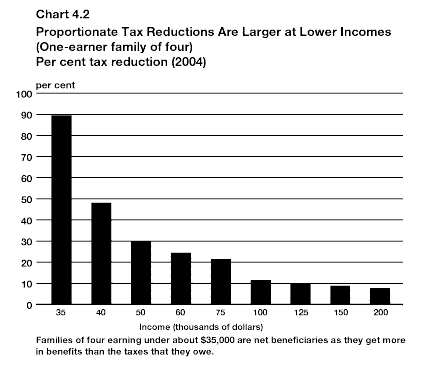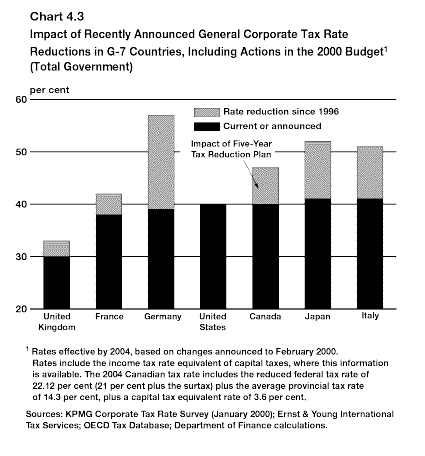
Finance Canada
Budget 2000 - Budget Plan, Chapter 4: Five-Year Tax Reduction Plan - 3
- Franšais - Table of Contents - Previous - Next
-
On an annual basis, the Five-Year Tax Reduction Plan will reduce federal personal income taxes by an average of at least 15 per cent by 2004-05 relative to the taxes otherwise payable. Combined with the actions in the 1997, 1998 and 1999 budgets, annual personal income tax reductions will total 22 per cent by 2004-05. For families with children and for low- and middle-income Canadians (Chart 4.2), the Plan will reduce personal income taxes significantly more.
Percentage Tax Reduction by 2004-05
Annual tax reduction |
Five-Year Tax Reduction Plan |
Five-Year Tax Reduction Plan and 1997, 1998 and 1999 budgets |
|---|---|---|
| Average all Canadians | 15 | 22 |
| Families with children | 21 | 30 |
| Low- and middle-income Canadians | 18 | 26 |
| Note: Further details can be found in Annex 7. | ||

To prosper in the global economy, Canada needs a business tax system that is internationally competitive. This is important because business tax rates have a significant impact on the level of business investment, employment, productivity, wages and incomes.
Canadian effective tax rates for small businesses, the manufacturing and processing (M&P) sector and the resource sector are by and large internationally competitive. As a result of special tax preferences, small businesses effectively have a federal tax rate of about 12 per cent while the M&P and resource sectors have a federal tax rate of about 21 per cent. However, other sectors of the economy are subject to the high general corporate tax rate without any special provisions. These highest taxed sectors include fast-growing service and high-technology firms that will influence the pace of Canada’s future economic and social development. In recent years, many industrialized countries have either reduced their corporate tax rates or announced their intention to lower them. If no action were taken, Canada’s general corporate tax rate would not be competitive with those of our trading partners.
The Government’s objective is to reduce, within five years, the federal corporate income tax rate to 21 per cent from 28 per cent on business income not currently eligible for special tax treatment. As a first step, the budget proposes to reduce this rate to 27 per cent effective January 1, 2001 (Table 4.2). Once fully implemented by 2004, the combined federal-provincial tax rate, including both income and capital taxes, would be reduced from the current average of 47 per cent to 40 per cent, a more competitive level vis-Ó-vis other G-7 countries.

Given the important role of small businesses in Canada, the Government believes that, in addition to the personal income tax rate reductions, they should benefit from lower corporate tax rates more rapidly. Therefore, the budget proposes that, beginning January 1, 2001, small businesses would benefit from a 21-per-cent corporate tax rate on business income between $200,000 and $300,000 (Table 4.2).
This faster access to the reduced rate reflects the seriousness of this government’s commitment to the small business sector.
The high-technology sector and other fast-growing industries are particularly important to Canada’s future economic growth. Our tax system must be conducive to innovation, and must ensure that businesses have access to the capital they need in an economy that is becoming increasingly competitive and knowledge-based. An examination of the taxation of capital gains in Canada suggests that this objective would be better achieved with a reduction in the inclusion rate of capital gains from the current three-quarters to two-thirds (Table 4.2). The budget proposes this change be effective after February 27, 2000.
Many employers use share ownership plans and stock options to encourage employees to become participating owners of their businesses, most notably in the fast-growing high-technology industries. Tax rules that apply to stock options and employee share ownership plans have been under review to ensure that they remain appropriate as the economy evolves. As part of the review to date, it has been determined that, in the case of employee stock options granted by publicly traded companies, the current practice of taxing benefits when employees exercise their options may force some employees to sell the shares immediately to pay the tax. The budget proposes that employee stock options granted by publicly traded companies be subject to tax only when the employee sells the shares.
The budget proposes to defer the income inclusion from exercising employee stock options for publicly listed shares until the disposition of the shares, subject to a $100,000 annual vesting limit, effective for options exercised after February 27, 2000 (Table 4.2). The same dollar limit applies in the United States.
Consistent with the reduction in the inclusion rate for capital gains from three-quarters to two-thirds, it is further proposed that the deduction currently available for employee stock options be increased to one-third. The stock option deduction reduces the tax rate on benefits from employee stock options to the same level as the tax rate on capital gains.
These measures will provide employees with an added incentive to participate with their employers in the growth and success of their business.
Promoting innovation and growth also means ensuring that businesses have access to the risk capital they need to expand and prosper. This is particularly true for high-technology businesses, which are becoming increasingly important for innovation and economic growth. While the venture capital market has expanded considerably in recent years, start-up firms continue to have difficulty accessing risk capital because venture capitalists often focus more on established businesses. One factor that limits access to capital for small businesses is the fact that investors disposing of existing business investments to reinvest in other businesses must pay tax on the capital gains realized on the previous investment. This reduces the amount of money available for investment in new ventures.
The budget proposes that individuals be able to defer the tax on capital gains from eligible small business investments, to the extent that proceeds are reinvested in another eligible small business investment by the earlier of 120 days after disposition or 60 days after the end of the calendar year. Each new investment eligible for the rollover cannot exceed $500,000. Eligible small business investments are newly issued shares in a small business corporation with assets not exceeding $2.5 million before the investment is made and not exceeding $10 million after the investment. This tax deferral will be available for dispositions after February 27, 2000.
This measure, in combination with the reduction in the capital gains inclusion rate, improves access to capital for small businesses with high growth potential. This will be of particular benefit to the fast-growing high-technology industries.
Table 4.2
Summary of Budget 2000 Tax Measures
| Areas for action | Actions proposed to be legislated through the 2000 budget | Amount of annual tax relief in 2004-05 (millions of dollars) |
|---|---|---|
| Eliminate automatic increases in the tax burden due to inflation |
|
See below |
|
2,0151 | |
| Reduce the high tax burden at the middle-income level |
|
2,410 |
|
1,8851 | |
|
3001 | |
|
365 | |
| Increase support for children |
|
2,1751 |
|
||
|
||
|
||
|
||
|
||
| Make the Canadian economy more internationally competitive |
|
455 |
|
100 | |
|
295 | |
|
75 | |
|
75 | |
| Other |
|
7801 |
| Total | 10,930 | |
| Of which indexation contributes | 6,215 | |
| 1 Amounts include indexation, based on an assumed annual inflation rate of 1.8 per cent. | ||
| Budget 2000 Publications | Budget 2000 Main Page |